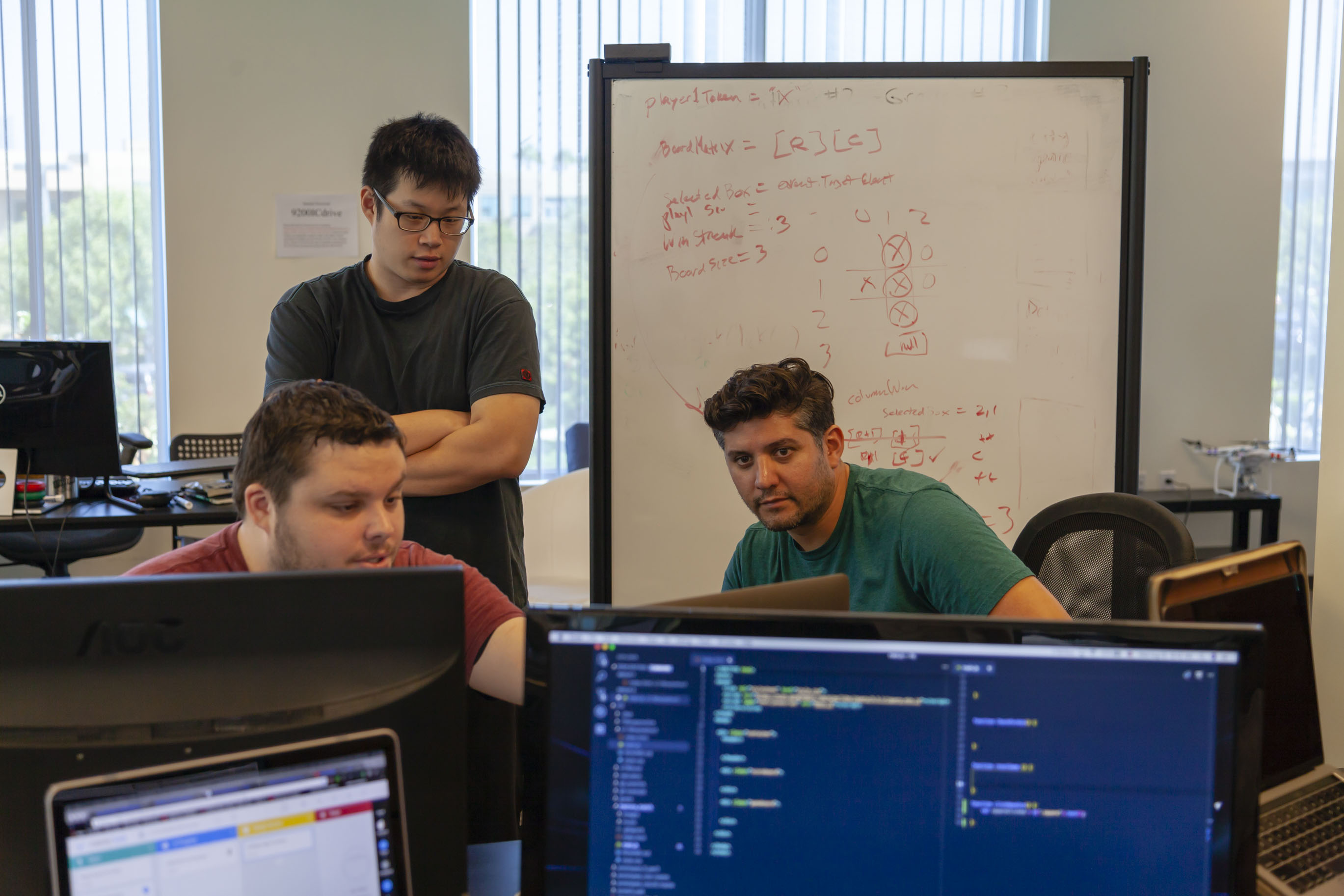What is a Full-Stack Engineer and How Do You Become One?
If you're fueled by a deep passion for technology and have a burning desire to immerse yourself in all facets of web development, a career as a full-stack engineer could be your true calling. Learning Fuze, renowned for its exceptional coding bootcamps, is here to shed light on the captivating industry of full-stack engineering. Our mission is to guide you through what it takes to become a full-stack engineer and to help you discover the skill set required for this exhilarating career path.
Learning Fuze's coding bootcamps are designed to provide you with the comprehensive knowledge and hands-on experience needed to thrive in the dynamic field of web development. We're dedicated to empowering aspiring full-stack engineers with the skills, expertise, and practical insights necessary to excel in both front-end and back-end development.
Whether you're completely new to coding or looking to enhance your existing skills, Learning Fuze's bootcamps offer a structured and supportive environment where you can learn, grow, and ultimately achieve your goal of becoming a proficient full-stack engineer.
What is a Full-Stack Engineer?
A full-stack engineer is a versatile and skilled developer who possesses the capabilities to work on both the front-end and back-end aspects of web applications. Their role is pivotal in the web development process, as they are responsible for building, maintaining, and enhancing websites to ensure they function seamlessly and deliver exceptional user experiences. Let's delve deeper into the distinct components that define a full-stack engineer:
Front-End Development: full-stack engineers are adept at crafting the user interfaces that people see and interact with on websites. This entails using a combination of languages, such as HTML, CSS, and JavaScript, to design the visual layout, style, and interactive elements of a website. They focus on creating the elements that users directly engage with, making the website visually appealing and user-friendly.
Back-End Development: In the realm of back-end development, full-stack engineers work on the server-side logic, databases, and the core functionality that powers a website. They employ a range of technologies like Node.js, Python, and utilize databases like MySQL to ensure that data is stored securely and accessed efficiently. Back-end development is all about building the functionality that enables the website to manage data, perform calculations, and deliver dynamic content.
Problem-Solving: full-stack engineers are naturally inclined to be problem-solvers. They excel at identifying and addressing issues within web applications, whether it's debugging code, optimizing performance, or implementing new features to enhance the overall user experience. Their analytical and troubleshooting skills are invaluable in maintaining and improving websites.
In essence, a full-stack engineer possesses the skills and knowledge to manage every aspect of web development, from creating visually appealing user interfaces to developing the robust, data-driven core that powers the site. This multifaceted expertise makes them an integral part of web development teams, contributing to the creation of high-quality, functional, and user-friendly websites.
Now that we understand what a full-stack engineer does, let's delve into the essential skills required to excel in this multifaceted role.
Essential Skills for Full-Stack Engineering
To become a full-stack engineer, you'll need a diverse skill set that combines both front-end and back-end development.
Proficiency in HTML, CSS, and JavaScript: Full-stack engineers must be experts in these languages to create responsive and visually appealing websites.
Front-End Frameworks: Mastery of front-end frameworks like React, Angular, or Vue.js is crucial for building dynamic user interfaces.
Back-End Development: Skills in back-end technologies such as Node.js, Python, Ruby on Rails, and PHP are essential for managing server-side operations.
Database Management: A strong understanding of databases like MySQL, PostgreSQL, or MongoDB is vital for handling data efficiently.
Version Control/Git: Full-stack engineers use Git to collaborate with other developers and manage version control.
Problem-Solving: The ability to troubleshoot issues and optimize performance is a fundamental skill for full-stack engineers.
Having covered the crucial skills for full-stack engineering, let's now explore how one can embark on the journey to become a proficient full-stack engineer.
How to Become a Full-Stack Engineer
To become a full-stack engineer, you have to start with education. Whether you choose to self-study, go to a 4-year institution, or join an accelerated bootcamp, it's important to understand your goals and timeline for your software journey so you can choose the right education path.
Coding bootcamps offer expert guidance, hands-on experience, and a structured curriculum to accelerate your learning. They provide a supportive environment to enhance your skills and confidence.
Step 1. Start with the Basics
Begin your journey by mastering the fundamentals of HTML, CSS, and JavaScript. These foundational languages serve as the building blocks of web development. Understand HTML for structuring web content, CSS for styling web pages, and JavaScript for adding interactivity and functionality to websites. These are the essential prerequisites to becoming a full-stack engineer.
Step 2. Learn Front-End Technologies
Dive deeper into front-end development by studying popular JavaScript frameworks such as React, Angular, or Vue.js. These frameworks empower you to create user-friendly interfaces and enhance the user experience. Front-end development revolves around what users see and interact with, so it's crucial to grasp these technologies to excel in full-stack engineering.
Step 3. Explore Back-End Development
To become a well-rounded full-stack engineer, it's vital to familiarize yourself with back-end technologies. Learn server-side scripting languages like Node.js, Python, Ruby on Rails, or PHP. Back-end development involves handling server-side logic and databases, ensuring that data flows seamlessly between the server and the user interface. This knowledge is essential for creating robust web applications.
Step 4. Build Projects
Practice makes perfect, and the best way to solidify your skills is by building real-world projects. As you tackle various projects, you'll encounter diverse challenges and learn how to overcome them. The more you code, the more proficient you become. Building projects also demonstrate your capabilities to potential employers and clients.
Step 5. Gain Problem-Solving Skills
Becoming an adept full-stack engineer isn't just about writing code; it's also about identifying and fixing issues within your projects. Problem-solving is a critical skill. You'll encounter bugs, glitches, and inefficiencies, and your ability to diagnose and resolve these problems will set you apart as a skilled engineer. Additionally, optimizing your code for performance is a key aspect of problem-solving.
Step 6. Create a Portfolio
Build a portfolio that showcases your projects, skills, and experience. A well-organized portfolio serves as a powerful tool for demonstrating your proficiency to potential employers and clients. Include a diverse range of projects that highlight your capabilities in both front-end and back-end development.
With your skills honed and a robust portfolio showcasing your projects, you're well-prepared to launch your exciting career in web development as a full-stack engineer. Begin your job search by seeking full-stack engineer positions that resonate with your interests and career aspirations.
As you prepare to take the crucial step of applying for jobs as a full-stack engineer, you'll be pleased to know that LearningFuze's commitment to your success extends beyond the classroom and into our lifetime career services program.
Embarking on the path to becoming a full-stack engineer is not merely a career choice; it's a fulfilling journey that allows you to harness the power of both front-end and back-end technologies. It's a journey where you'll encounter challenges, but it's also a path filled with endless opportunities for growth and innovation.
This journey represents a unique blend of creativity and problem-solving, making it an attractive option for those who thrive on pushing the boundaries of what's possible in web development.
So, whether you're an aspiring coder looking to broaden your horizons or someone with a specific goal of becoming a full-stack engineer, LearningFuze is your ideal partner. Your journey into the exciting world of full-stack engineering begins here.
Additional Resources
You might like these

April 5, 2024
Learn essential software design principles for robust, efficient code. Join LearningFuze's bootcamps for expert guidance in software engineering.

Learn the key to software development success with programming fundamentals. Discover career opportunities with LearningFuze's coding bootcamp job placement.

March 5, 2024
Practice CSS and JavaScript technical assessment questions to prepare for your next software engineering interview with sample questions covering display values, CSS rules, JavaScript arrays, and operators.





